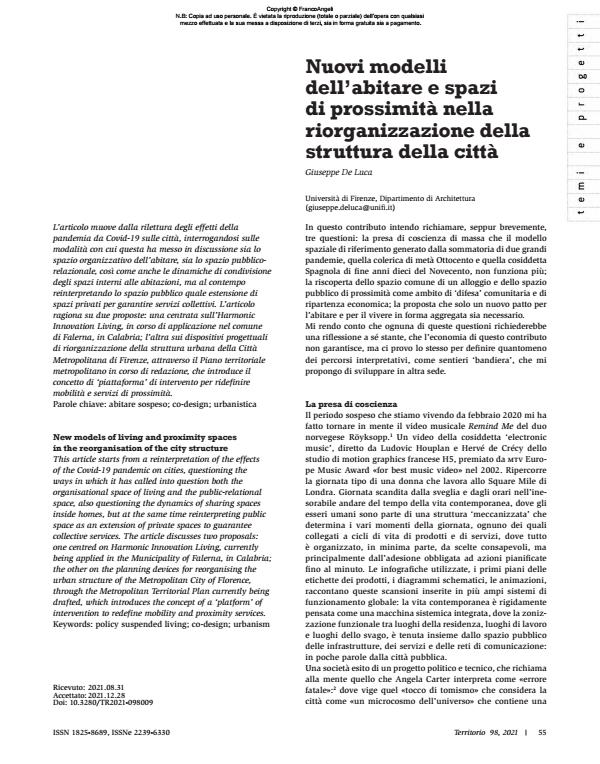New models of living and proximity spaces in the reorganisation of the city structure
Journal title TERRITORIO
Author/s Giuseppe De Luca
Publishing Year 2022 Issue 2021/98 Language Italian
Pages 7 P. 55-61 File size 356 KB
DOI 10.3280/TR2021-098009
DOI is like a bar code for intellectual property: to have more infomation
click here
Below, you can see the article first page
If you want to buy this article in PDF format, you can do it, following the instructions to buy download credits

FrancoAngeli is member of Publishers International Linking Association, Inc (PILA), a not-for-profit association which run the CrossRef service enabling links to and from online scholarly content.
This article starts from a reinterpretation of the effects of the Covid-19 pandemic on cities, questioning the ways in which it has called into question both the organisational space of living and the public-relational space, also questioning the dynamics of sharing spaces inside homes, but at the same time reinterpreting public space as an extension of private spaces to guarantee collective services. The article discusses two proposals: one centred on Harmonic Innovation Living, currently being applied in the Municipality of Falerna, in Calabria; the other on the planning devices for reorganising the urban structure of the Metropolitan City of Florence, through the Metropolitan Territorial Plan currently being drafted, which introduces the concept of a ‘platform’ of intervention to redefine mobility and proximity services.
Keywords: policy suspended living; co-design; urbanism
- Amendola G., 2020, a cura di, L’immaginario e le epidemie. Bari: Mario Adda Edizioni. American Public Health Association, Committee on Hygiene of Housing, 1948, Planning the Neighborhood, Public Administration Service, Chicago.
- Barberis V., 2020, «Harmonic Innovation Living. Un nuovo modello di abitare per comunita resilienti». Nuovi paradigmi urbani e abitativi per la citta post pandemia. Urbanpromo. Milano, 18 settembre 2020.
- Bélanger P., 2017, Landscape as infrastructure: a base primer. New York: Routledge. DOI: 10.4324/9781315629155
- Carter A., 1995, Macchine infernali del desiderio. Milano: tea.
- Cicione F., De Biase L., 2021, Innovazione armonica. Un senso di futuro. Soveria Mannelli (cz): Rubbettino.
- De Luca G., 2021, «Towards Harmonic Space Planning?». In: Cicione F., Filice L., Marino D. (eds.), Harmonic Innovation. Super Smart Society 5.0 and Technological Humanism. Cham, Switzerland: Springer Nature.
- Perry C.A., 1929, «The Neighborhood Unit: a Scheme of Arrangement for the Family Life Community». In: Regional Plan of New York and its Environs, Vol. VII, New York.
- Tyler R.W., 1939, «The Neighborhood Unit Principle in Town Planning». The Town Planning Review, 18, 3: 174-186. -- www.jstor.org/stable/40101826.
- Spazi di prossimità scolastica narrati attraverso il digital storytelling, tra tradizione e innovazione Alessia Rosa, Sara Mori, Michela Bongiorno, in IUL Research 3/2023 pp.44
DOI: 10.57568/iulresearch.v4i8.469
Giuseppe De Luca, Nuovi modelli dell’abitare e spazi di prossimità nella riorganizzazione della struttura della città in "TERRITORIO" 98/2021, pp 55-61, DOI: 10.3280/TR2021-098009